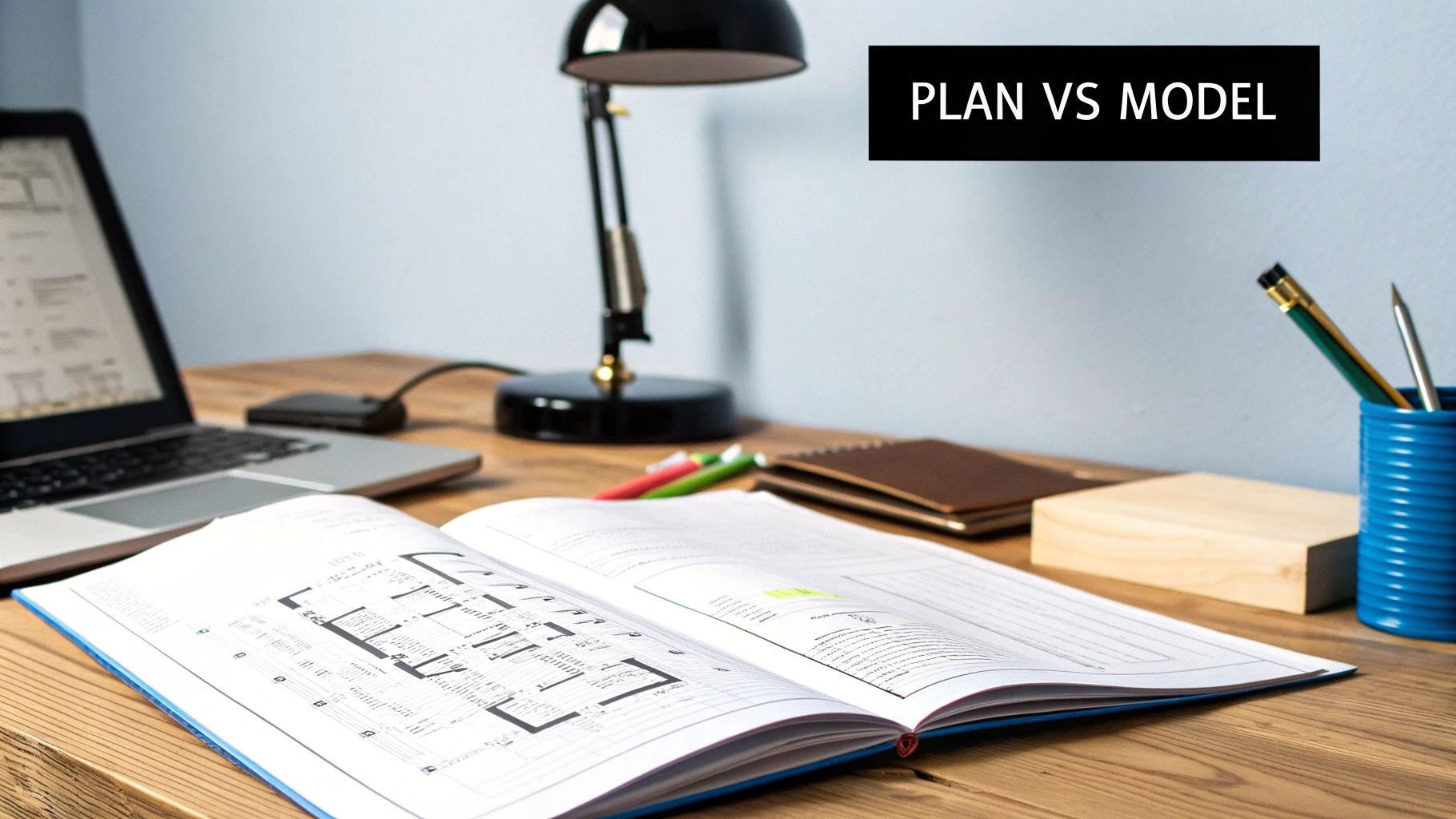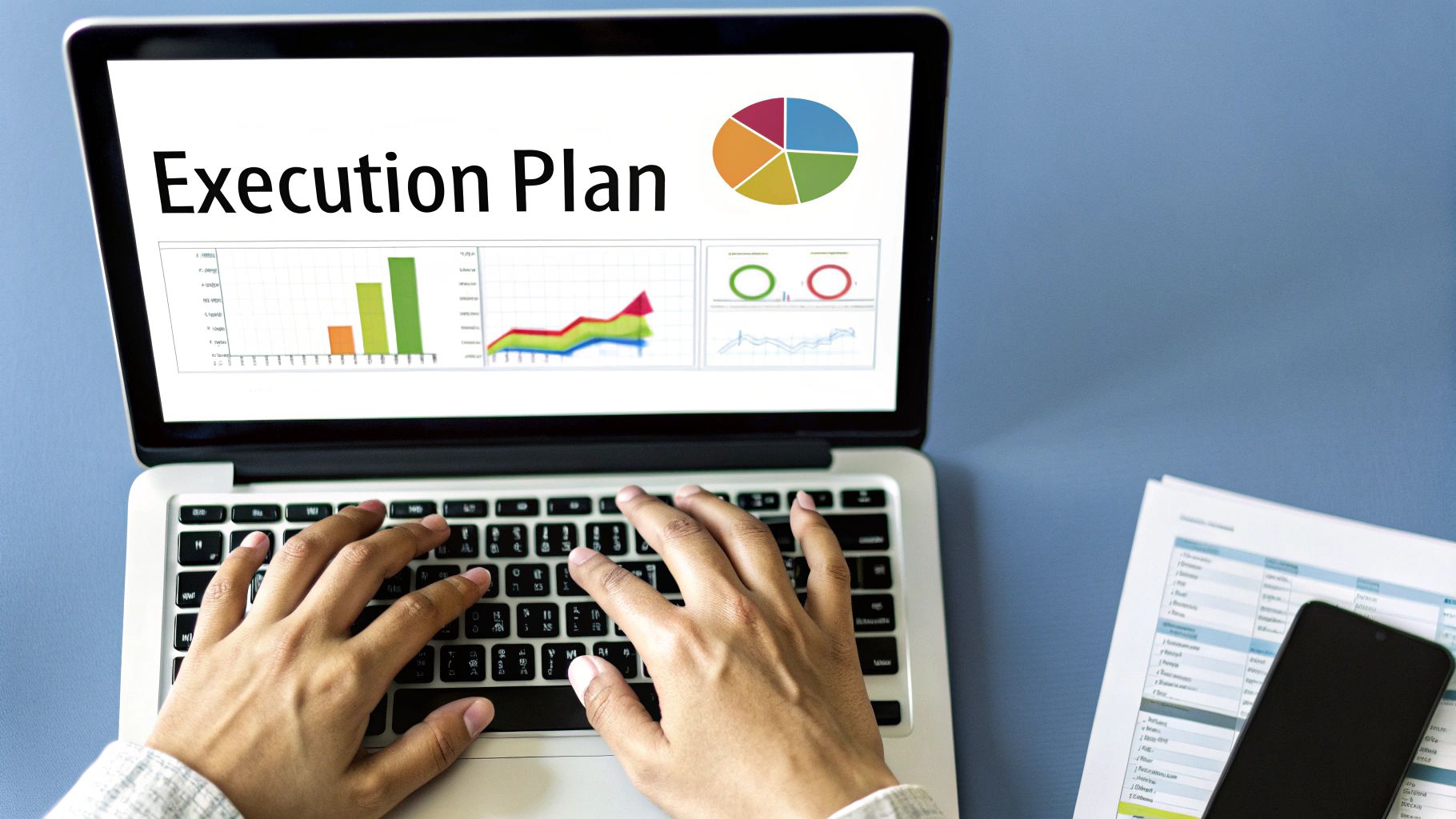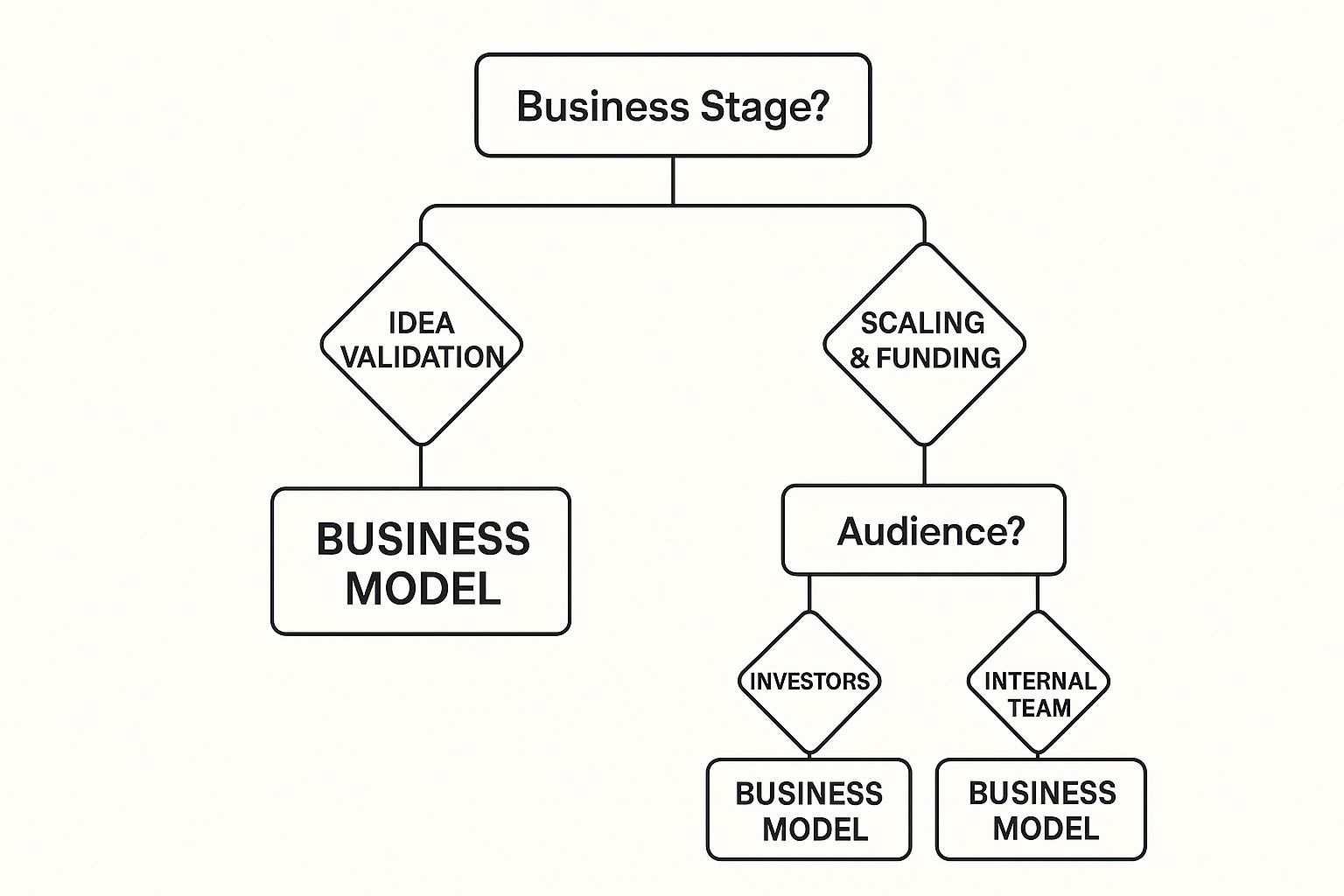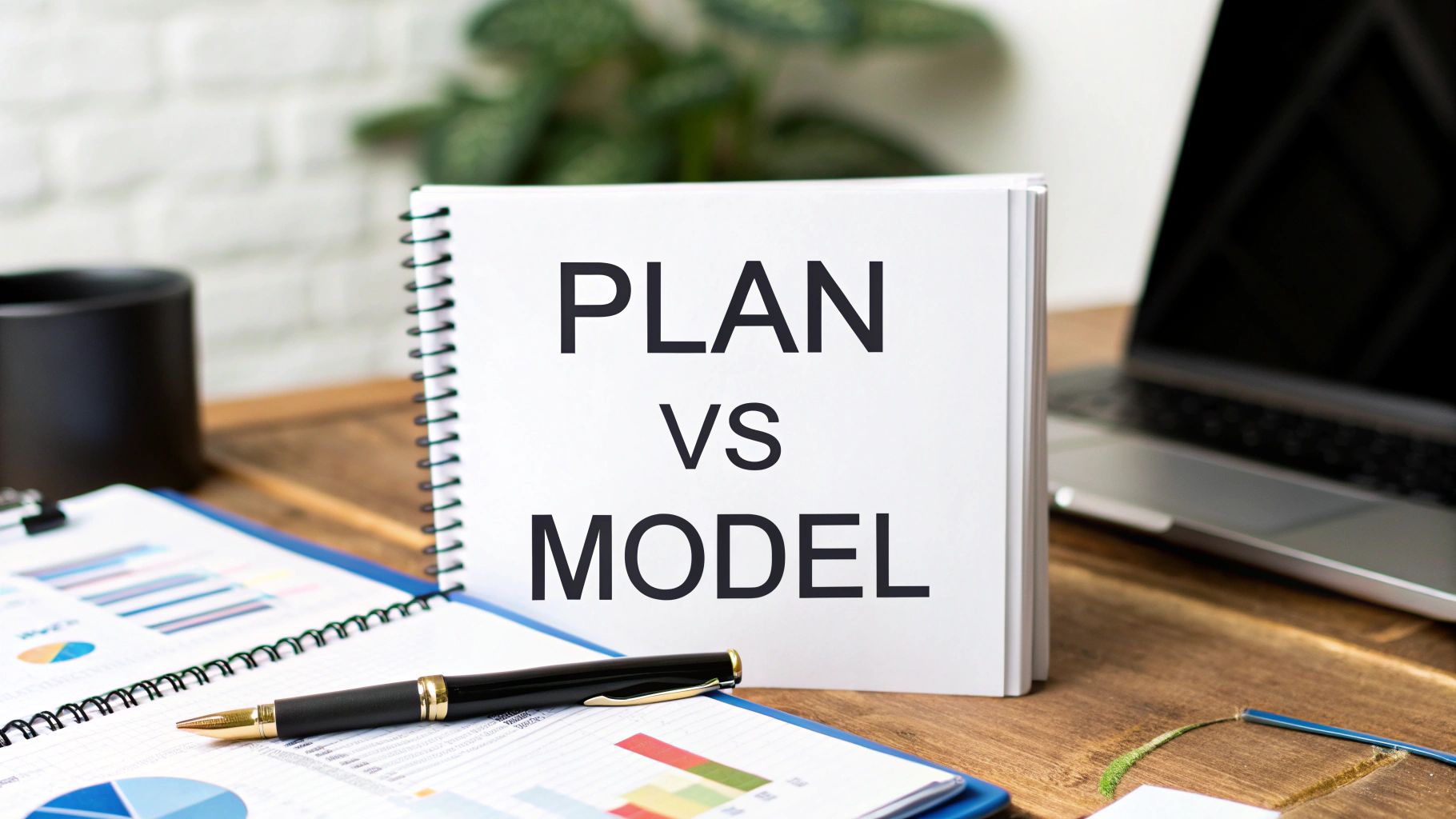A business plan and a business model are often thrown around in the same conversation, but they serve completely different purposes for a small business. It boils down to this: your business model is your strategy for how you'll make money, while your business plan is your roadmap for actually doing it.
For a small business owner, the model answers the what and why—what value do you offer, and why will people pay for it? The plan gets into the nitty-gritty of how and when, detailing things like your marketing and operations.
Clarifying Your Business Foundation
If you're a small entrepreneur, you've probably heard "business plan" and "business model" used interchangeably. This is a common point of confusion, but they represent two very distinct—and equally critical—parts of turning a great idea into a real, thriving small business. Getting this right from the start lays the groundwork for everything that follows.
Think of your business model as the conceptual blueprint for your venture. It’s a high-level sketch that explains how you’ll create value, deliver it to customers, and capture it as profit. It's the fundamental logic of your business.

A business plan, on the other hand, is the formal, written document that maps out your operational, marketing, and financial goals. This is the detailed guide you’ll show to lenders, investors, or even just use to keep yourself on track. The model is about strategy; the plan is all about execution.
Business Model vs Business Plan At a Glance
Let's break down the fundamental differences between these two crucial documents. Understanding where each one fits helps a small business owner focus their efforts on the right task at the right time.
The table below offers a quick side-by-side look at what sets them apart.
| Attribute | Business Model | Business Plan |
|---|---|---|
| Purpose | Outlines the core logic of how the business creates value and generates revenue. | Provides a detailed roadmap for operations, marketing, and achieving financial goals. |
| Audience | Primarily internal for the entrepreneur to test and refine strategy. | Primarily external for investors, banks, and stakeholders to secure funding or support. |
| Focus | Strategic: What is your value proposition and who are your customers? | Tactical: How will you reach customers and when will you hit milestones? |
| Format | Often a one-page visual canvas (e.g., Business Model Canvas). | A detailed, multi-page text document with comprehensive financial statements. |
Ultimately, the scope says it all. Your business model is a lean, agile framework that you can test and pivot quickly. Your business plan is a comprehensive document, often 20-50 pages long, built on the foundation your model provides. It's the detailed story you tell others to get them to believe in—and fund—your vision.
How a Business Model Defines Your Value
Think of it this way: if your business plan is the GPS navigating you to a destination, your business model is the car itself. It's the core engine that explains exactly how your small business creates something of value, gets it into the hands of customers, and makes money in the process. Before you ever map out the A-to-B journey, you have to know if the vehicle can even run.
A solid business model gets right to the heart of the matter. Who are my customers, really? What burning problem am I actually solving for them? And critically, how will I get paid for it? For any small entrepreneur, answering these questions isn't just a thought exercise—it's the entire foundation of a business that can actually last.

This isn't just theory; the data backs it up. A famous analysis of startup failures discovered that a staggering 42% failed simply because there was no market need for what they built. They had a plan, sure, but their fundamental business model was flawed from day one. It's no wonder that today, many successful small entrepreneurs start by sketching out a business model to test their core idea before pouring their energy into a detailed plan.
The Nine Building Blocks of Your Business
One of the best tools for getting this down on paper is the Business Model Canvas. It’s a simple but powerful framework that breaks your entire operation down into nine essential components, giving you a crystal-clear, one-page snapshot of how everything fits together.
Let's walk through these building blocks.
-
Customer Segments: Who are you really serving? You have to get specific here. A neighborhood bakery isn't just for "everyone." It might serve "time-crunched morning commuters" and "local families planning birthday parties"—two totally different groups with very different needs.
-
Value Propositions: What's in it for them? For commuters, the bakery’s value is speed, convenience, and a great cup of coffee. For families, the value is celebration, creativity, and a custom-designed cake. You can see a great breakdown of this in our sample coffee shop business model.
-
Channels: How will you actually reach these people? This covers everything from your marketing plan to sales. The bakery uses its physical storefront for commuters, Instagram to showcase custom cakes, and maybe a local delivery app to reach people at home.
Key Takeaway: Your business model isn't something you write once and forget. It's a living tool for challenging your own assumptions and making sure your idea has legs before you bet the farm on it.
Mapping Your Financial and Operational Logic
The next set of blocks is where the rubber meets the road, connecting your big idea to the financial reality of running a small business.
- Customer Relationships: How do you interact with each group? Commuters expect fast, friendly, transactional service. Cake clients, on the other hand, need personal consultations and a more hands-on relationship.
- Revenue Streams: Where does the money come from? It could be from one-time sales (a daily latte and croissant) or project-based fees (a custom wedding cake order).
- Key Resources: What do you absolutely need to make this work? This includes the obvious stuff like ovens and a storefront, but also intellectual property like unique recipes and, of course, your talented bakers.
- Key Activities: What are the most important things you have to do every day? For the bakery, it’s baking consistently great products, managing ingredient inventory, and keeping customers happy.
- Key Partnerships: Who do you rely on? This could be your local dairy farmer, a specialty coffee roaster, or the company that supplies your packaging. When you're sketching this out, gaining competitive insight helps you see who the key players in your market are and how you can stand out.
- Cost Structure: What are your biggest expenses? Think ingredient costs, rent for your shop, staff wages, and marketing.
Laying out these nine blocks lets you see your entire business strategy on a single page. It instantly shows you how everything is connected, where the potential weak spots are, and settles the business plan vs business model debate—you have to have a strong model first.
How a Business Plan Guides Your Execution
Think of your business model as the architect's grand vision for a building. The business plan, on the other hand, is the contractor's day-by-day, brick-by-brick construction schedule. It's where the high-level strategy of your model gets translated into the nitty-gritty "how" and "when" of actually getting things done.
This is the document that guides your real-world decisions—from allocating your marketing budget to hiring your first employee.
For any small entrepreneur, the moment you move from a working model to a formal plan is a huge step. It’s the official pivot from brainstorming to building. A business plan forces you to sweat the details and map out a clear path forward, leaving no stone unturned.

More than anything, this plan becomes your accountability partner. While a business model can (and should) be flexible, a business plan is built on concrete milestones, deadlines, and financial targets. It’s a firm commitment you make to your team and yourself, laying out measurable goals that keep everyone pulling in the same direction.
The Essential Components of an Actionable Plan
The idea of writing a "traditional" business plan can sound a bit stuffy, but for a small business, it’s really just a series of logical chapters that tell your company's full story. Each piece builds on the last, creating a solid narrative that's essential if you're talking to lenders, investors, or potential partners.
Let’s quickly walk through the core sections you can't skip:
-
Executive Summary: This is your elevator pitch on paper. It's a single, powerful page that sums up your entire plan. You actually write it last, but it goes right at the front to hook the reader with your mission, market opportunity, and financial highlights.
-
Company Description: Here’s where you lay out the basics: your legal structure, your mission, and exactly what problem you solve for customers. This section gives your small business its identity.
-
Market Analysis: Time to show you’ve done your homework. You'll define your ideal customer, size up your industry, and give an honest look at your competition. A deep understanding of the market shows you're serious.
-
Organization and Management: People don't just invest in ideas; they invest in the entrepreneur behind them. This is where you introduce your core team, highlighting their expertise and who's responsible for what.
A business plan is more than a document for securing funding; it's an internal compass. For small entrepreneurs, it provides operational clarity that turns ambitious goals into achievable daily tasks.
From Strategy to Sales and Financials
Once you've laid the foundation, the rest of your plan gets tactical. This is where you connect the dots between your business model's assumptions and the real-world, data-backed steps you'll take to succeed, especially in your marketing and sales efforts.
The Marketing and Sales Plan section needs to explain exactly how you plan to find and win over customers. For a small business, this is crucial. It should include a robust Go-To-Market strategy that details your launch, pricing, sales process, and promotional plans.
Right after that comes the Financial Projections. This is where you put numbers to the narrative, and it's often the most scrutinized section of the whole document. Typically, you'll need:
- Income Statements: Your projected revenue, costs, and profit over the first 3-5 years.
- Cash Flow Statements: A forecast showing how cash will move in and out of the business—crucial for managing operations without running out of money.
- Balance Sheets: A snapshot of your company's assets, liabilities, and equity at a specific point in time.
Finally, if you need capital, the Funding Request spells it out. You’ll state exactly how much you need, precisely how you'll spend it, and what terms you’re offering in return. This level of detail is what separates a cool idea from a fundable business, giving investors the confidence that your venture isn't just a dream, but a sound investment.
The Big Shift: From Stiff Plans to Fluid Models
For ages, the thick, leather-bound business plan was the gold standard for any serious entrepreneur. It was a rite of passage—a hefty document you spent months perfecting before you could even think about asking for funding. But let’s be real, the world doesn’t move at that pace anymore, especially for small businesses.
There’s been a massive shift in thinking. Agility is the new currency, not exhaustive detail. We're in a world where you can get customer feedback in an afternoon and market trends can flip overnight. This new reality called for a new kind of tool, one built for speed and real-world testing.
It's All About the Customer Now
The old-school business plan was often written in a bubble. Small entrepreneurs would hole up for months, crafting a masterpiece based on pure guesswork. Then they’d launch, only to find out nobody actually wanted what they were selling. A huge waste of time, money, and passion.
Today's approach turns that completely on its head. The first and most important question is simple: Does anyone actually want this thing? And are they willing to pay for it? That’s where the business model comes in. It's a dynamic, visual sketchpad for your idea, designed to be tested, challenged, and changed on the fly based on what real people tell you.
This isn’t just a fad; it’s a strategic imperative. In a world that never sits still, the business model is your flexible guide for discovery. The business plan is the detailed roadmap you create once you know the destination is worth traveling to.
Following the Money: From Bank Loans to Lean Startups
History tells the story perfectly. Business plans became a big deal after World War II when companies needed to show bankers they were a safe bet for a loan. But as the market got faster, that slow, clunky process became a huge drag on small, nimble businesses.
This friction paved the way for something better. We needed faster, more adaptive tools, which led to game-changers like the Business Model Canvas in 2010. Alexander Osterwalder’s one-page visual chart was a breath of fresh air compared to the dusty tomes of the past. If you want to dig deeper into this, you can find plenty of great discussions online about the business model versus the business plan.
Today, the "model-first" approach is gospel for entrepreneurs. The best startup accelerators on the planet demand a validated business model long before they’ll even glance at a full plan. This really highlights the evolution in the business plan vs business model debate. The plan isn't dead—not by a long shot. Its role has just changed. It’s now the second step, the tool you use to execute once you’ve proven your core idea actually works. This sequence makes sure you're building a business on a solid foundation of real customer value—creating something not just well-planned, but resilient.
Choosing the Right Tool for Your Business Stage
So, we've broken down the theory, but let's get practical for a small entrepreneur. Knowing the difference between a business plan and a business model is one thing; knowing which one you need to be working on right now is what really counts.
This isn’t just an academic exercise. It's a strategic choice that hinges on where you are in your journey, who you’re talking to, and what your next big goal is. Get it wrong, and you could waste weeks on a document you don't need. A 50-page business plan is massive overkill if you're still figuring out if people will even buy your product. On the flip side, a one-page canvas won't get you a bank loan.
The goal is to match the tool to the task. This decision tree lays it out simply.

As you can see, everything starts with your business stage. Are you still trying to validate an idea, or are you ready to scale a proven concept? Your answer to that question points you to the right tool.
The Idea and Validation Stage
If your small business is still just a spark—an idea you're trying to shape—your job is all about validation. You need to get answers to some fundamental questions. Does anyone actually need this? Who are my real customers? How will I get paid?
At this point, the business model is your best friend. It’s lean, visual, and designed to be changed on the fly.
Let’s say you're a solo entrepreneur planning to launch a local dog-walking service. You absolutely do not need a 40-page document with five-year financial forecasts. What you do need is a Business Model Canvas to quickly sketch out your assumptions and start testing them.
- Who's the customer? Is it the busy young professional or the elderly pet owner?
- What's the real value? Is it just exercise for the dog, or peace of mind for the owner?
- How does it make money? Is it a one-time walk, a monthly subscription package, or add-on services?
This is a process of discovery, not documentation. Your model helps you pivot fast without getting stuck in the concrete of a formal plan. Think of it as a dynamic worksheet, not a static report.
Your business model is your laboratory. It’s where you run experiments on your core assumptions to find a formula that works before you invest heavily in building out the full operation.
The Funding and Scaling Stage
Once you've got a validated business model—meaning you have actual proof that customers want what you’re selling—your priorities shift. The game changes from discovery to execution. Now, it's all about growth, operations, and securing resources.
This is where the business plan takes center stage.
Suddenly, your audience isn't just you. You're talking to investors, bankers, and potential partners. These people demand detail, foresight, and cold, hard proof of viability. They need to see a clear, documented road to profitability.
Imagine a small bakery that’s a hit in its neighborhood. The concept is proven, the customers are loyal, and now the owner wants to open a second location. To get a small business loan, she'll need to walk into the bank with a comprehensive business plan that includes:
- Detailed Financial Projections: Clear income statements, cash flow forecasts, and balance sheets that prove the expansion is a sound investment.
- Market Analysis: Hard data on the new location's demographics and a serious look at the competition.
- A Detailed Marketing Plan: A specific, actionable plan for getting customers in the door of the new shop.
- Operational Plan: The nitty-gritty details on staffing, supply chains, and day-to-day management.
In this situation, a one-page business model just won't cut it. The lender needs to see that the owner has sweated every tactical detail and thought through the risks. Before you get this deep into planning, running a formal assessment can save a lot of headaches; you can see how we structure this in our guide on conducting a feasibility study.
Ultimately, the business plan is what turns a proven model into a fundable, scalable company.
To make it even clearer, let's look at a few common scenarios small entrepreneurs face and which document makes the most sense.
When to Use a Business Model vs a Business Plan
| Scenario | Primary Tool | Reasoning |
|---|---|---|
| You have a new Etsy shop idea and need to test pricing. | Business Model | Perfect for iterating on revenue streams and value propositions quickly. |
| You're applying for an SBA loan to buy equipment for your cafe. | Business Plan | Lenders require detailed financial projections and operational plans. |
| You're trying to explain your freelance service idea to a potential partner. | Business Model | A visual canvas helps communicate the core concept and potential clearly. |
| A local investor is interested but wants a 5-year forecast. | Business Plan | Investors need a formal document to perform due diligence. |
| You want to add a catering service to your existing restaurant. | Business Model | It's a low-cost way to map out and test assumptions for the new service. |
| You're creating an internal roadmap for your team for the next year. | Business Plan | It provides the strategic direction, milestones, and KPIs for execution. |
This table should help you pinpoint exactly where you are and what you need to focus on next. It's all about using the right tool for the job to move your small business forward.
Making Your Model and Plan Work Together
It’s easy to get caught up in the "business plan vs. business model" debate, as if you have to choose one over the other. For a small entrepreneur, they’re not rivals. Think of them as two critical legs of the same journey, taking you from a bright idea to a real, sustainable business.
Your business model is the creative spark—the very soul of your operation. The business plan is the skeleton that gives that soul a body, providing structure and strength. One simply can't function properly without the other. It's this partnership that turns a concept into something tangible, fundable, and ready to grow.
From Model to Plan: A Step-By-Step Flow
The process here follows a natural, logical order. You always start with the model to make sure your core idea even works. Then, you build the plan to bring that validated idea to life. This sequence is crucial; it stops you from wasting months creating a detailed map for a destination no one actually wants to visit.
Here’s a practical look at how the pieces of your model feed directly into your plan:
-
Customer Segments → Market Analysis: Those specific customer groups you outlined in your business model? They become the bedrock of the market analysis in your business plan. Your model answers who your customers are; your plan digs up the hard data on market size, demographics, and buying habits for those exact people.
-
Value Proposition → Marketing Plan: The unique promise you make to your customers—your value proposition—is the headline of your marketing strategy. The plan then gets into the weeds, detailing how you’ll communicate that value through specific channels, pricing, and promotions.
-
Revenue Streams → Financial Projections: The ways you make money in your model (like subscriptions or one-off sales) are the inputs for your financial projections. In the business plan, you attach real numbers to these streams, forecasting revenue, cash flow, and profit for the next 3-5 years.
Following this flow is non-negotiable. A business plan written without a tested model is just a fancy work of fiction—a collection of well-researched guesses.
A business model gives your plan credibility. It shows you’ve moved past pure assumption and have actual evidence that your core strategy works in the real world.
An Example in Action: A Small Entrepreneur's Journey
Let's follow a solo founder launching a subscription box for eco-friendly cleaning products. Her journey shows this process perfectly.
She starts with a Business Model Canvas to sketch out her idea. She identifies her key customer segment as "environmentally-conscious urban millennials." Her value proposition is simple: "convenience and the discovery of non-toxic products." Her revenue stream is a monthly subscription. Before going all-in, she tests these ideas with online surveys and a small pilot program, confirming people are willing to pay for her service.
Now that she has a proven model, she needs a small business loan to buy more inventory and kickstart her marketing. It’s time to write her business plan.
- Her Market Analysis section doesn't just ramble about the cleaning industry. It presents specific data on the growth of the eco-conscious millennial demographic in her target cities.
- Her Marketing Plan lays out a detailed strategy to reach these customers through Instagram influencers and partnerships with zero-waste bloggers—channels she knows they frequent and trust.
- Her Financial Projections use the validated $29.99/month price point from her pilot to create believable sales forecasts, not just wishful thinking.
Her business plan isn't some theoretical document. It’s a compelling story backed by the proof she gathered while building and testing her model. This is how a simple idea becomes a fundable, actionable roadmap.
Frequently Asked Questions
It’s natural to have questions when you’re wrestling with the big picture of strategy versus the nitty-gritty of execution. Let's tackle some of the most common questions entrepreneurs and small business owners face when figuring out their business plan and business model.
Which One Should I Create First?
For almost any new venture, start with the business model. Before you pour countless hours into a detailed, formal plan, you absolutely have to confirm your core idea holds water.
Think of your business model as the lab where you test your assumptions. It forces you to prove there’s a real customer who wants what you're offering and a sensible way to make money from it. Once that foundation is solid, building out the detailed business plan becomes a much more confident and focused exercise.
Do I Really Need Both?
Eventually, yes. They play different, but deeply connected, roles for a small business. The model is your strategic blueprint—the essential first step for validating your idea. The plan is your operational roadmap—the tool you'll need to get funding, align your team, and manage your growth.
A business model without a business plan is just a clever idea with no way to make it happen. A business plan without a solid business model is a detailed map to a place nobody actually wants to go.
How Often Should I Update Them?
Treat both as living documents, but they don't need the same amount of attention.
- Business Model: Revisit this quarterly, or anytime you're thinking about a major strategic shift, like entering a new market. A big change here—a pivot—should always be a deliberate move based on real feedback from your customers.
- Business Plan: This needs an update at least annually, or anytime you’re preparing to seek new investment. It has to reflect your current financial reality, the latest market conditions, and your immediate operational targets.
Your business model defines the long-term strategic game you're playing. Your business plan is the tactical playbook that needs to stay current with your company's progress and the world around it.
For a deeper dive into common startup queries, you can explore more answers in our comprehensive FAQ section. This resource can help clarify other foundational aspects of launching and growing your venture.
Ready to stop guessing and start building? GrowthGrid uses AI to generate a complete, professional business plan in under 15 minutes. Move from a great idea to an actionable roadmap today. Create Your Business Plan Now.
